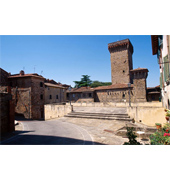LUCIGNANO
From Monte San Savino, it is easy to reach another small township abounding in artistic works, LUCIGNANO. Situated on the edge of a hill in lands that were already inhabited in Etruscan times, the town grew out of a Roman “castrum” or military camp, strategically located in this important position on the road between Arezzo and Siena. For this very reason, the site was the subject of conflicts between the two cities and, later on, between Perugia and Florence. Present-day Lucignano has retained unchanged the elliptical plan and street layout which it was given between the 12th and 14th centuries. The ellipse developed around the oval shape of the early medieval nucleus of buildings. Entering through Porta San Giusto, you come to Piazza Caduti della Libertà, and the 14th-century Cassero, or castle keep, rises above the piazza. It possesses a square tower with a portico built in the 18th century to the design of Andrea Pozzo. The same artist designed the stage-set of steps that go up to the Collegiata di San Michele Arcangelo which was built in 1594 on the site of an older church by the artist from Monte San Savino, Orazio Porta. Inside the single nave, you will find two statues by Andrea Pozzo, St Peter and St Paul. Matteo Rosselli the Florentine artist painted the Visitation of the Blessed Virgin to St Elizabeth in 1631, and another Florentine, Onorio Marinari, painted the Death of St Joseph in 1668-1670. St Charles visiting those stricken with the Plague and the Martyrdom of St Lucy were done by Giacinto Gimignani who learnt his art in Cortona. In the Chapel of the Blessed Sacrament, built between 1668 and 1672, there are frescoes painted by Luigi Ademollo between 1792 and 1798. Behind the Collegiate Church, you will find the 14th-century Palazzo Comunale which looks on to the Piazza del Tribunale and inside which the Museo Comunale has been housed since1984. In the Museum’s collection, there is a 14th-century Madonna and Child Enthroned with Saints by the Sienese artist, Lippo Vanni, St Francis receiving the Stigmata by Luca Signorelli, a Madonna and Child Enthroned with a Female Donor by Niccolò di Segna, and a triptych by Bartolo di Fredi.
However, the most singular and most precious item in the Museum is the reliquary known as the Albero di Lucignano, called so because it has the shape of a tree. The Albero is made of gold-plated copper and silver, and the branches are of coral and rock crystal and hold miniature images. This complex work, which was started in 1350 but not finished until 1471, was assigned to master craftsmen from Siena and Arezzo and also to Gabriele d’Antonio.
From the right of the Palazzo Comunale, you go down to the Chiesa di San Francesco which was built during the 13th century and retains its Romanesque grey and white façade with a Gothic portal. The floor plan is a Coptic cross with a single nave. The church possesses the remains of some frescoes ascribed to Bartolo di Fredi, Taddeo di Bartolo and other artists from Siena who were working between the 14th and 15th centuries, and among these is the Triumph of Death. The polyptych at the high altar, the Madonna and Child with Saints, is ascribed to Luca di Tommè and was painted during the second half of the 14th century. From the right of San Francesco, you reach the Oratorio di Santa Maria della Misericordia, or Our Lady of Mercy, which was founded before 1468 and reconstructed before 1583. Inside, there is a single nave and a Nativity at the main altar which is perhaps by Orazio Porta. At the side altars, there are two works from 1699, an Annunciation by Onorio Marinari from 1699 and an Assumption of the Blessed Virgin by Alessandro Gherardini. Outside Porta San Giusto but near Lucignano, you find the Santuario di Santa Maria della Querce which grew up around an image of the Blessed Virgin painted in 1417 by Feliciano Batone. In 1467 a miracle related to this image took place and a chapel was built. It was substituted in 1564 by the building you see today ascribed to Giorgio Vasari. Inside, there is a painting from 1625 by the Florentine artist Matteo Rosselli.
|
|

|
|

